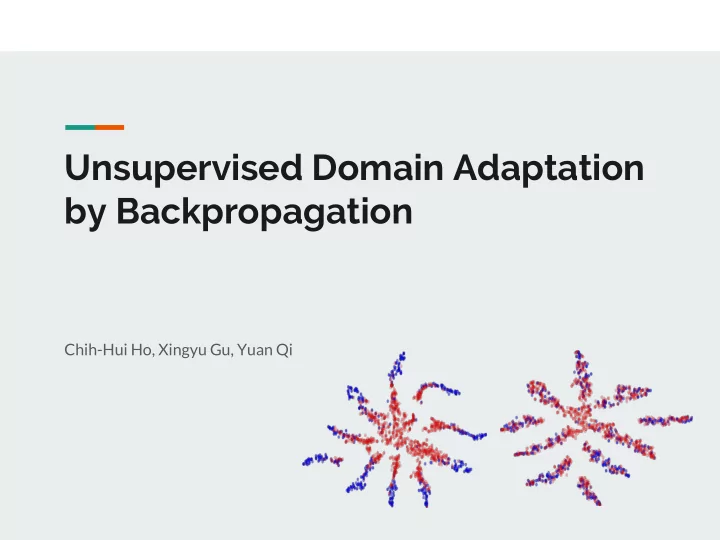

Unsupervised Domain Adaptation by Backpropagation Chih-Hui Ho, Xingyu Gu, Yuan Qi
Outline ● Introduction ● Related works ● Proposed solution ● Experiments ● Conclusions
Problems Deep network : requires massive labeled training data. Labeled data : Available sometimes: ● Image recognition ○ Speech recognition ○ Recommendation ○ Difficult to collect sometimes: ● Robotics ○ Disaster ○ Medical diagnosis ○ Bioinformatics ○
Problems Test time failure : distribution of actual data is different from training data. Example: Model is Trained on synthetic data (abundant and fully labeled), but ● Tested on real data . ● MJSynth (synthetic) IIIT5K (real)
Source datapoint Results ● Target datapoint ● MNIST → MNIST-M (extracted features) ● Adaptation SYN NUMBERS → SVHN (label classifier’s last hidden layer) ● Adaptation
Objective Given: Lots of labeled data in the source domain (e.g. synthetic images) ● Lots of unlabeled data in the target domain (e.g. real images) ● Domain Adaptation ( DA ): In the presence of a shift between source and target domain, Train a network on source domain that performs well on target domain.
Objective Example: Office dataset Source : ● Amazon photos of office objects (on white background) Target : ● Consumer photos of office objects (taken by DSLR camera / webcam)
Previous Approaches - DLID D eep L earning by I nterpolating between D omains Feature transformation mapping source into target. ● Train feature extractor layer-wise. ○ Gradually replacing source samples with target samples. ○ Train classifier on features. ○
Previous Approaches - MMD M aximum M ean D iscrepancy (measures domain-distance) Reweighting target domain images. ● Distance between source and target distributions. ○ Explicit distance measurement (e.g. kernel Hilbert space). ○
Proposed Solution - Deep Domain Adaptation (DDA) Standard CNN + domain classifier . An implicit way to measure similarity between source and target. ● If domain classifier performs good : dissimilar features. ○ If domain classifier performs bad : similar features. ○ Objective: feature is best for label classifier, and ● worst for domain classifier.
Improvement Previous approaches Proposed solution Measurement of Implicit Explicit similarity between (performance of domain (distance in Hilbert space) domains classifier) Separate feature extractor Jointly trained by Training steps and label classifier backpropagation Simple Architecture Complicated (standard CNN + domain classifier)
Proposed Solution ●
Proposed Solution ●
Proposed Solution – Label predictor ●
Proposed Solution ●
Proposed Solution ●
Proposed Solution Consider an image from source domain
Proposed Solution Consider an image from target domain ---
Proposed Solution
Proposed Solution ●
Proposed Solution How to backpropagate the label classifier loss? ● Consider only the upper architecture ● This is typical backpropagation ●
Proposed Solution How to backpropagate the domain classifier loss? ● Consider only the upper architecture ● Define gradient reversal layer (GRL) ● +
Proposed Solution ● Forward Backward
Proposed Solution After training, the label predictor can be used to predict labels ● for samples from either source or target domain Experiment results ●
Source & Target Datasets
MNIST → MNIST-M
MNIST → MNIST-M
Synthetic numbers → SVHN
Synthetic numbers → SVHN
MNIST ↔ SVHN The two directions (MNIST → SVHN and SVHN → MNIST) are not equally difficult. SVHN is more diverse, a model trained on SVHN is expected to be more generic and to perform reasonably on the MNIST dataset. Unsupervised adaptation from MNIST to SVHN gives a failure example for this approach.
SVHN → MNIST
Synthetic Signs → GTSRB
Synthetic Signs → GTSRB This paper also evaluates the proposed algorithm for semi-supervised domain adaptation, i.e. when one is additionally provided with a small amount of labeled target data.
Office dataset
Conclusions ● Proposed a new approach to unsupervised domain adaptation of deep feed-forward architectures; ● Unlike previous approaches, this approach is accomplished through standard backpropagation training; ● The approach is scalable, and can be implemented using any deep learning package.
Recommend
More recommend